Flavor Profiling by Consumers Segmented According to Product Involvement and Food Neophobia
Abstract
:1. Introduction
2. Materials and Methods
2.1. Samples
2.1.1. Materials
2.1.2. Sample Design
2.1.3. Sample Preparation and Presentation
2.2. Taste and Flavor Descriptors
2.3. Subjects
2.4. Procedure
2.5. Data Analysis
3. Results
3.1. Subject Groups According to Product Involvement Level and Food Neophobia Level
3.2. Effects of Samples
3.3. Effects of Product Involvement (PII)
3.4. Effects of Food Neophobia (FNS)
3.5. Product Involvement and Food Neophobia Interactions
4. Discussion
Author Contributions
Funding
Informed Consent Statement
Data Availability Statement
Conflicts of Interest
References
- Williams, A.A.; Langron, S.P. The use of free-choice profiling for the evaluation of commercial ports. J. Sci. Food Agric. 1984, 35, 558–568. [Google Scholar] [CrossRef]
- Lawless, H.T.; Sheng, N.; Knoops, S.S. Multidimensional scaling of sorting data applied to cheese perception. Food Qual. Prefer. 1995, 6, 91–98. [Google Scholar] [CrossRef]
- Dairou, V.; Sieffermann, J.M. A comparison of 14 jams characterized by conventional profile and a quick original method, the flash profile. J. Food Sci. 2002, 67, 826–834. [Google Scholar] [CrossRef]
- Pagès, J. Direct collection of sensory distances: Application to the evaluation of ten white wines of the Loire Valley. Sci. Aliments 2003, 23, 679–688. [Google Scholar] [CrossRef]
- Adams, J.; Williams, A.; Lancaster, B.; Foley, M. Advantages and uses of check-all-that-apply response compared to traditional scaling of attributes for salty snacks. In Proceedings of the 7th Pangborn Sensory Science Symposium, Minneapolis, MN, USA, 12–16 August 2007. [Google Scholar]
- Ares, G.; Bruzzone, F.; Vidal, L.; Cadena, R.S.; Giménez, A.; Pineau, B.; Hunter, D.C.; Paisley, A.G.; Jaeger, S.R. Evaluation of a rating-based variant of check-all-that-apply questions: Rate-all-that-apply (RATA). Food Qual. Prefer. 2014, 36, 87–95. [Google Scholar] [CrossRef]
- Varela, P.; Ares, G. Sensory profiling, the blurred line between sensory and consumer science. A review of novel methods for product characterization. Food Res. Int. 2012, 48, 893–908. [Google Scholar] [CrossRef]
- Lee, S.M.; Kim, S.-E.; Guinard, J.-X.; Kim, K.-O. Exploration of flavor familiarity effect in Korean and US consumers’ hot sauces perceptions. Food Sci. Biotechnol. 2016, 25, 745–756. [Google Scholar] [CrossRef]
- Moskowitz, H.R. Experts versus consumers: A comparison. J. Sens. Stud. 1996, 11, 19–37. [Google Scholar] [CrossRef]
- Stone, H.; Sidel, J.L. Sensory Evaluation Practices; Elsevier Academic Press: Cambridge, MA, USA, 2004. [Google Scholar]
- Stone, H.; Bleibaum, R.; Thomas, H.A. Sensory Evaluation Practices; Academic Press: Cambridge, MA, USA, 2012. [Google Scholar]
- Costa, A.I.A.; Jongen, W.M.F. New insights into consumer-led food product development. Trends Food Sci. Technol. 2006, 17, 457–465. [Google Scholar] [CrossRef]
- De Pelsmaeker, S.; Gellynck, X.; Delbaere, C.; Declercq, N.; Dewettinck, K. Consumer-driven product development and improvement combined with sensory analysis: A case-study for European filled chocolates. Food Qual. Prefer. 2015, 41, 20–29. [Google Scholar] [CrossRef]
- Grunert, K.G.; Valli, C. Designer-made meat and dairy products: Consumer-led product development. Livest. Prod. Sci. 2001, 72, 83–98. [Google Scholar] [CrossRef]
- Jaeger, S.R.; Rossiter, K.L.; Wismer, W.V.; Harker, F.R. Consumer-driven product development in the kiwifruit industry. Food Qual. Prefer. 2003, 14, 187–198. [Google Scholar] [CrossRef]
- Linnemann, A.R.; Benner, M.; Verkerk, R.; van Boekel, M.A.J.S. Consumer-driven food product development. Trends Food Sci. Technol. 2006, 17, 184–190. [Google Scholar]
- Prescott, J.; Monteleone, E. Consumer perceptions of food and beverage flavour. In Flavour Development, Analysis and Perception in Food and Beverages; Elsevier: Amsterdam, The Netherlands, 2015. [Google Scholar]
- van Kleef, E.; van Trijp, H.C.M.; Luning, P. Consumer research in the early stages of new product development: A critical review of methods and techniques. Food Qual. Prefer. 2005, 16, 181–201. [Google Scholar] [CrossRef]
- Næs, T.; Varela, P.; Berget, I. Individual Differences in Sensory and Consumer Science; Woodhead Publishing: Cambridge, UK, 2018. [Google Scholar]
- Tormod, N.; Brockhoff, P.B.; Tomic, O. Statistics for Sensory and Consumer Science; John Wiley & Sons: Hoboken, NJ, USA, 2011. [Google Scholar]
- Zaichkowsky, J.L. Conceptualizing involvement. J. Advert. 1986, 15, 4–34. [Google Scholar] [CrossRef]
- Kotler, P.; Keller, K.L. Dirección de Marketing; Pearson Educación: Mexico City, Mexico, 2009. [Google Scholar]
- Pliner, P.; Hobden, K.L. Development of a scale to measure neophobia in humans the trait of food. Appetite 1992, 19, 105–120. [Google Scholar] [CrossRef]
- Eertmans, A.; Victoir, A.; Vansant, G.; Van den Bergh, O. Food-related personality traits, food choice motives and food intake: Mediator and moderator relationships. Food Qual. Prefer. 2005, 16, 714–726. [Google Scholar] [CrossRef]
- Jaeger, S.R.; Rasmussen, M.A.; Prescott, J. Relationships between food neophobia and food intake and preferences: Findings from a sample of New Zealand adults. Appetite 2017, 116, 410–422. [Google Scholar] [CrossRef]
- Kim, S.-E.; Lee, S.M.; Kim, K.-O. Consumer acceptability of coffee as affected by situational conditions and involvement. Food Qual. Prefer. 2016, 52, 124–132. [Google Scholar] [CrossRef]
- Monteleone, E.; Spinelli, S.; Dinnella, C.; Endrizzi, I.; Laureati, M.; Pagliarini, E.; Sinesio, F.; Gasperi, F.; Torri, L.; Aprea, E.; et al. Exploring influences on food choice in a large population sample: The Italian Taste project. Food Qual. Prefer. 2017, 59, 123–140. [Google Scholar] [CrossRef]
- Zickgraf, H.F.; Schepps, K. Fruit and vegetable intake and dietary variety in adult picky eaters. Food Qual. Prefer. 2016, 54, 39–50. [Google Scholar] [CrossRef]
- Frandsen, L.W.; Dijksterhuis, G.B.; Martens, H.; Martens, M. Consumer evaluation of milk authenticity explained both by consumer background characteristics and by product sensory descriptors. J. Sens. Stud. 2007, 22, 623–638. [Google Scholar] [CrossRef]
- Frandsen, L.W.; Dijksterhuis, G.B.; Brockhoff, P.B.; Nielsen, J.H.; Martens, M. Feelings as a basis for discrimination: Comparison of a modified authenticity test with the same–different test for slightly different types of milk. Food Qual. Prefer. 2007, 18, 97–105. [Google Scholar] [CrossRef]
- Bell, R.; Marshall, D.W. The construct of food involvement in behavioral research: Scale development and validation. Appetite 2003, 40, 235–244. [Google Scholar] [CrossRef]
- Williams, E.J. Experimental designs balanced for the estimation of residual effects of treatments. Aust. J. Sci. Res. 1949, 2, 149–168. [Google Scholar] [CrossRef]
- Marshall, D.; Bell, R. Relating the food involvement scale to demographic variables, food choice and other constructs. Food Qual. Prefer. 2004, 15, 871–879. [Google Scholar] [CrossRef]
- Zaichkowsky, J.L. Measuring the involvement construct. J. Consum. Res. 1985, 12, 341–352. [Google Scholar] [CrossRef]
- Stocks, M.; Shepherd, D.; Lee, H.S.; van Hout, D.; Hautus, M.J. Cognitive decision strategies adopted by consumers in reminder difference tests: Influence of the authenticity test. Food Res. Int. 2017, 97, 265–271. [Google Scholar] [CrossRef]
- Peter, J.P.; Olson, J.C. Consumer Behavior & Marketing Strategy; McGraw-Hill Higher Education: New York, NY, USA, 2010. [Google Scholar]
- Schiffman, L.; Kanuk, L.L. Consumer Behavior, Global Tenth Edition; Pearson Education: Upper Saddle River, NJ, USA, 2010. [Google Scholar]
- Solomon, M.R. Consumer Behavior; Pearson Education: Boston, MA, USA, 2013. [Google Scholar]
- Smith, R.E.; Swinyard, W.R. Attitude-behavior consistency: The impact of product trial versus advertising. J. Mark. Res. 1983, 20, 257–267. [Google Scholar] [CrossRef]
- Ares, G.; Besio, M.; Giménez, A.; Deliza, R. Relationship between involvement and functional milk desserts intention to purchase. Influence on attitude towards packaging characteristics. Appetite 2010, 55, 298–304. [Google Scholar] [CrossRef]
- Raudenbush, B.; Frank, R.A. Assessing food neophobia: The role of stimulus familiarity. Appetite 1999, 32, 261–271. [Google Scholar] [CrossRef] [PubMed]
- Frank, R.A.; Raudenbush, B. Individual differences in approach to novelty: The case of human food neophobia. In Viewing Psychology as a Whole: The Integrative Science of William N. Dember; Hoffman, R.R., Sherrick, M.F., Warm, J.S., Eds.; American Psychological Association: Washington DC, USA, 1998; pp. 227–245. [Google Scholar]
- Brockhoff, P.M.; Skovgaard, I.M. Modelling individual differences between assessors in sensory evaluations. Food Qual. Prefer. 1994, 5, 215–224. [Google Scholar] [CrossRef]
- O’Mahony, M. Sensory Evaluation of Food: Statistical Methods and Procedures; CRC Press: Boca Raton, FL, USA, 1986. [Google Scholar]
- Romano, R.; Brockhoff, P.B.; Hersleth, M.; Tomic, O.; Næs, T. Correcting for different use of the scale and the need for further analysis of individual differences in sensory analysis. Food Qual. Prefer. 2008, 19, 197–209. [Google Scholar] [CrossRef]
- Brockhoff, P.B.; Schlich, P.; Skovgaard, I. Taking individual scaling differences into account by analyzing profile data with the Mixed Assessor Model. Food Qual. Prefer. 2015, 39, 156–166. [Google Scholar] [CrossRef]
- Brockhoff, P.M. Assessor modelling. Food Qual. Prefer. 1998, 9, 87–89. [Google Scholar] [CrossRef]
- Kuznetsova, A.; Christensen, R.H.; Bavay, C.; Brockhoff, P.B. Automated mixed ANOVA modeling of sensory and consumer data. Food Qual. Prefer. 2015, 40, 31–38. [Google Scholar] [CrossRef]
- Næs, T.; Langsrud, Ø. Fixed or random assessors in sensory profiling? Food Qual. Prefer. 1998, 9, 145–152. [Google Scholar] [CrossRef]
- Næs, T. Handling individual differences between assessors in sensory profiling. Food Qual. Prefer. 1990, 2, 187–199. [Google Scholar] [CrossRef]
- Lim, J. Hedonic scaling: A review of methods and theory. Food Qual. Prefer. 2011, 22, 733–747. [Google Scholar] [CrossRef]
- Meilgaard, M.C.; Carr, B.T.; Civille, G.V. Sensory Evaluation Techniques; CRC Press: Boca Raton, FL, USA, 1999. [Google Scholar]
- Kähkönen, P.; Tuorila, H. Consumer responses to reduced and regular fat content in different products: Effects of gender, involvement and health concern. Food Qual. Prefer. 1999, 10, 83–91. [Google Scholar] [CrossRef]
- Choe, J.Y.; Cho, M.S. Food neophobia and willingness to try non-traditional foods for Koreans. Food Qual. Prefer. 2011, 22, 671–677. [Google Scholar] [CrossRef]
- Jeon, S.-Y.; Kim, K.-O.K. Effect of portion size on long-term acceptability as affected by consumers’ neophobia level: A case study on flavored green-tea drinks. Food Qual. Prefer. 2018, 63, 63–72. [Google Scholar] [CrossRef]
- Meiselman, H.L.; King, S.C.; Gillette, M. The demographics of neophobia in a large commercial US sample. Food Qual. Prefer. 2010, 21, 893–897. [Google Scholar] [CrossRef]
- Tuorila, H.; Lähteenmäki, L.; Pohjalainen, L.; Lotti, L. Food neophobia among the Finns and related responses to familiar and unfamiliar foods. Food Qual. Prefer. 2001, 12, 29–37. [Google Scholar] [CrossRef]
- Hursti, U.-K.K.; Sjödén, P.-O. Food and general neophobia and their relationship with self-reported food choice: Familial resemblance in Swedish families with children of ages 7–17 Years. Appetite 1997, 29, 89–103. [Google Scholar] [CrossRef]
- Siegrist, M.; Hartmann, C.; Keller, C. Antecedents of food neophobia and its association with eating behavior and food choices. Food Qual. Prefer. 2013, 30, 293–298. [Google Scholar] [CrossRef]
- Koivisto, U.-K.; Sjödén, P.-O. Food and general neophobia in Swedish families: Parent–child comparisons and relationships with serving specific foods. Appetite 1996, 26, 107–118. [Google Scholar] [CrossRef] [PubMed]
- Nordin, S.; Broman, D.A.; Garvill, J.; Nyroos, M. Gender differences in factors affecting rejection of food in healthy young Swedish adults. Appetite 2004, 43, 295–301. [Google Scholar] [CrossRef] [PubMed]
- Olabi, A.; Najm, N.E.O.; Baghdadi, O.K.; Morton, J.M. Food neophobia levels of Lebanese and American college students. Food Qual. Prefer. 2009, 20, 353–362. [Google Scholar] [CrossRef]
- Pliner, P.; Melo, N. Food neophobia in humans: Effects of manipulated arousal and individual differences in sensation seeking. Physiol. Behav. 1997, 61, 331–335. [Google Scholar] [CrossRef]
- Mustonen, S.; Oerlemans, P.; Tuorila, H. Familiarity with and affective responses to foods in 8–11-year-old children. The role of food neophobia and parental education. Appetite 2012, 58, 777–780. [Google Scholar] [CrossRef] [PubMed]
- Mustonen, S.; Tuorila, H. Sensory education decreases food neophobia score and encourages trying unfamiliar foods in 8–12-year-old children. Food Qual. Prefer. 2010, 21, 353–360. [Google Scholar] [CrossRef]
- Prescott, J.; Lee, S.M.; Kim, K.O. Analytic approaches to evaluation modify hedonic responses. Food Qual. Prefer. 2011, 22, 391–393. [Google Scholar] [CrossRef]
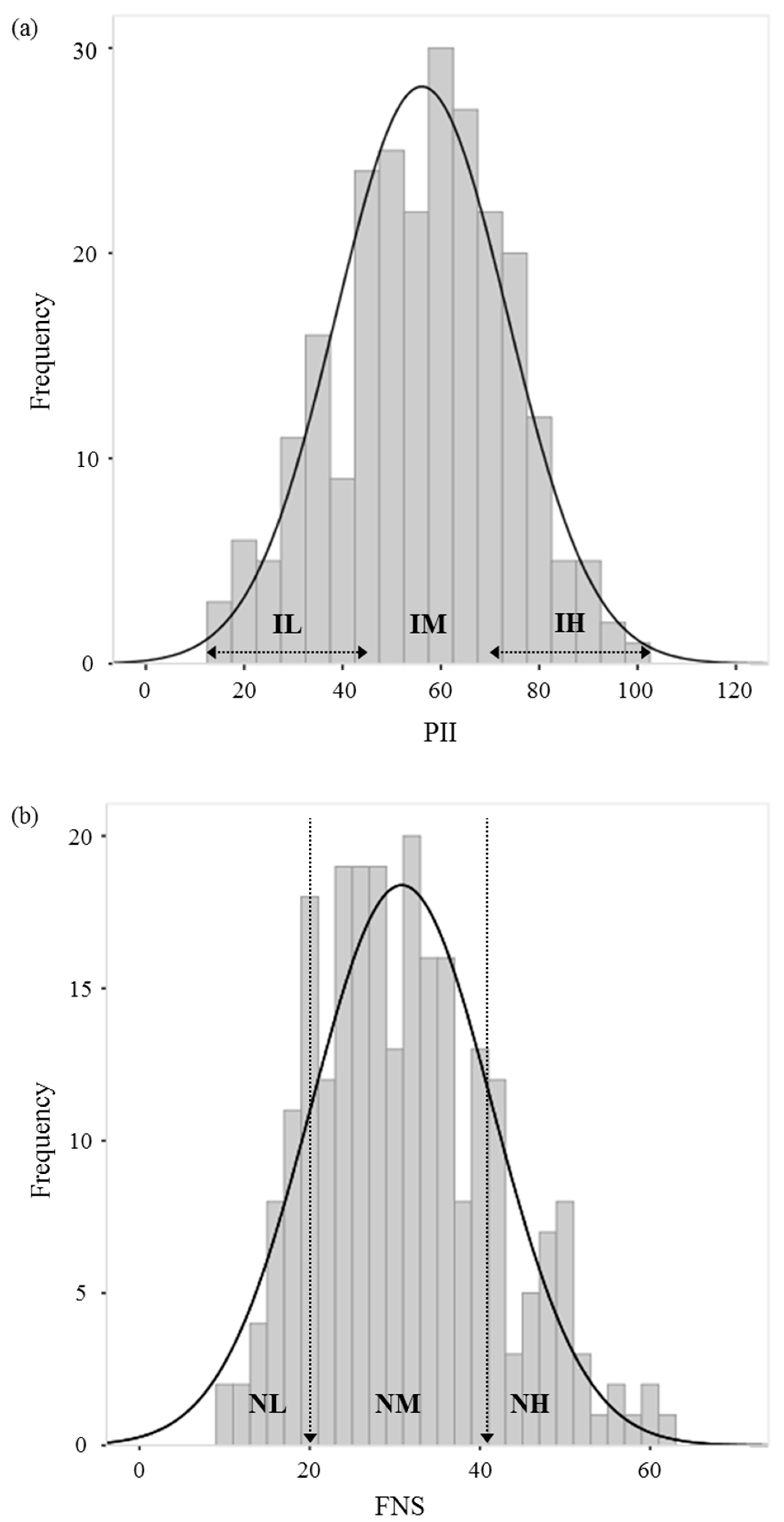
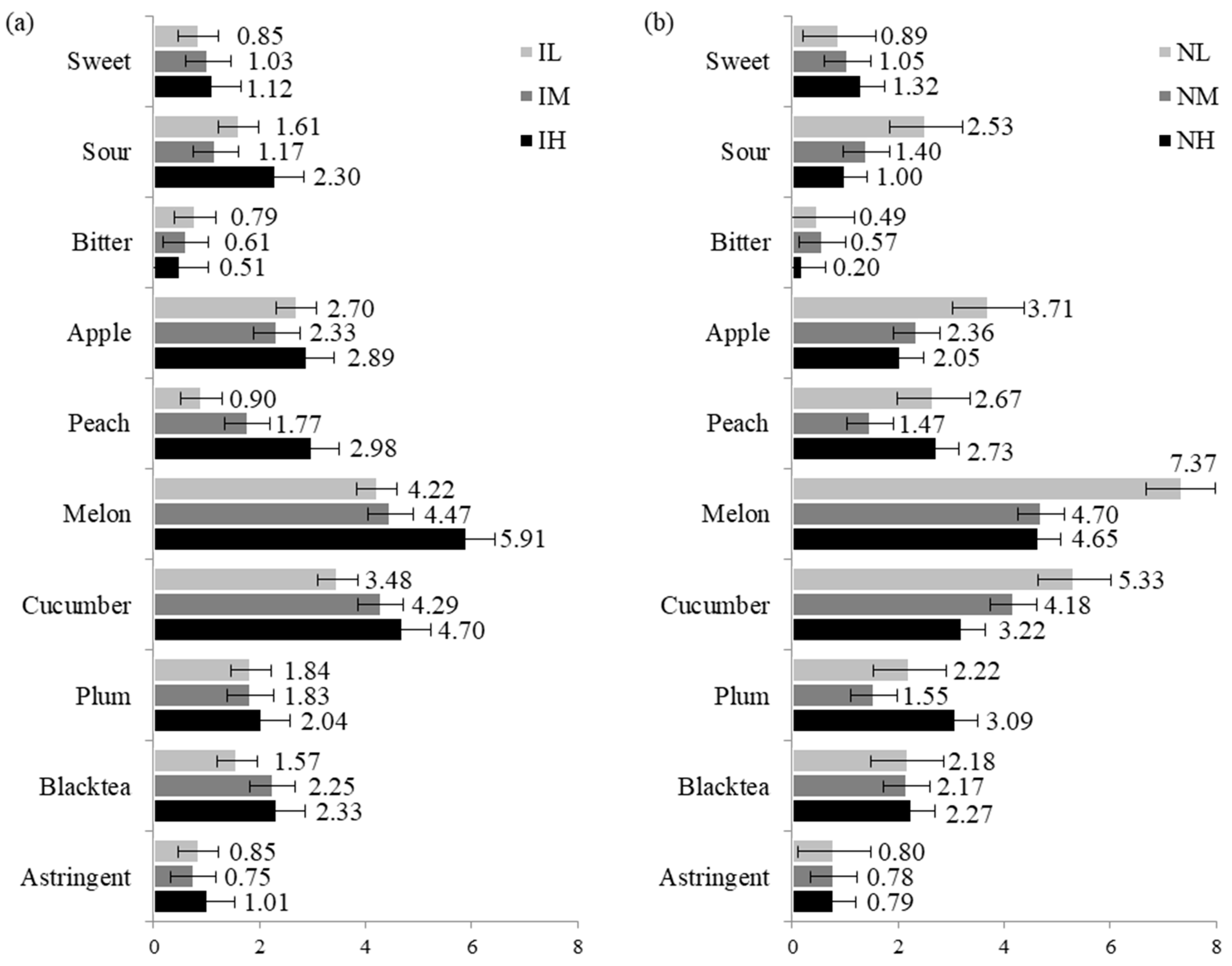
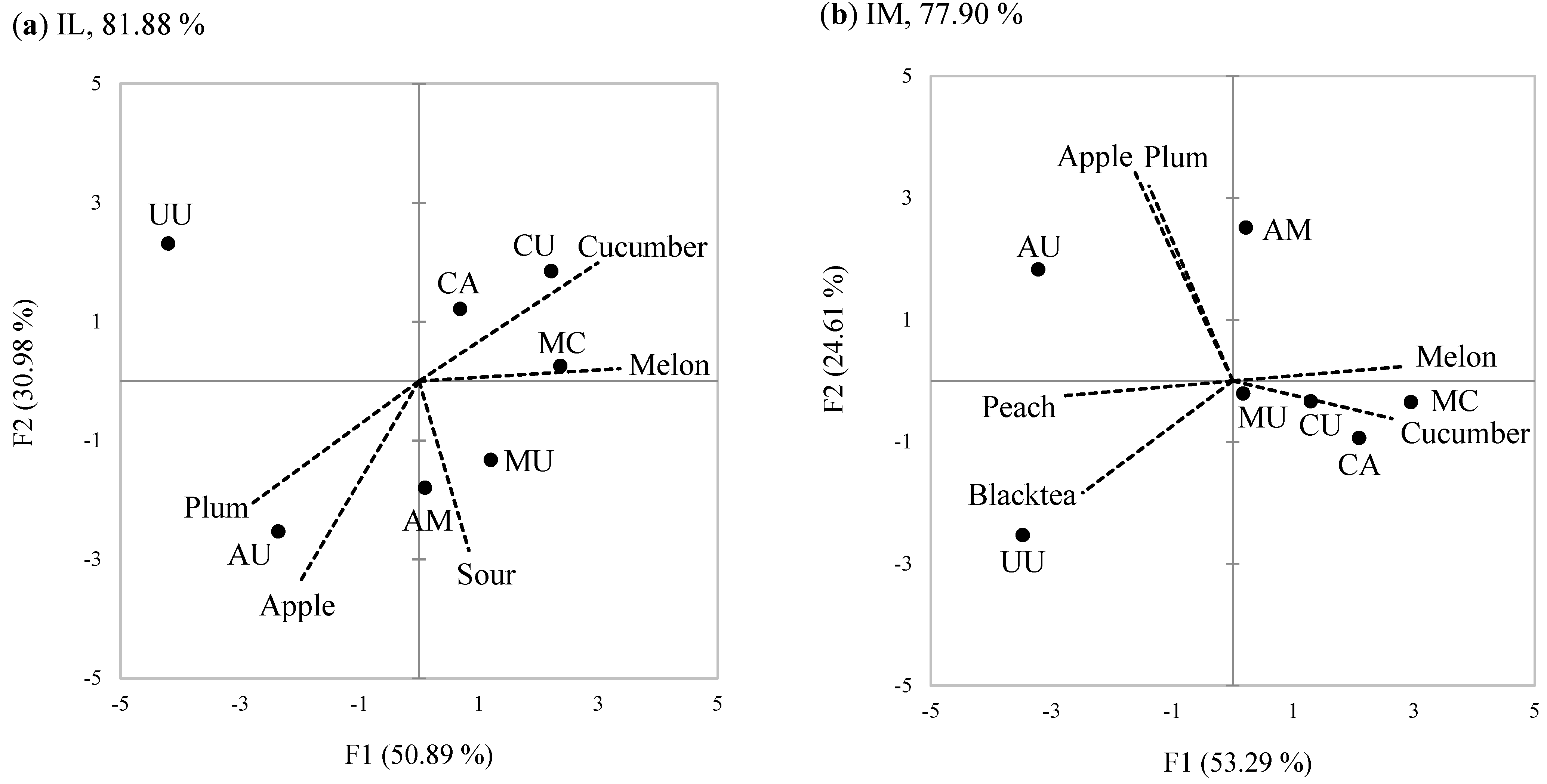
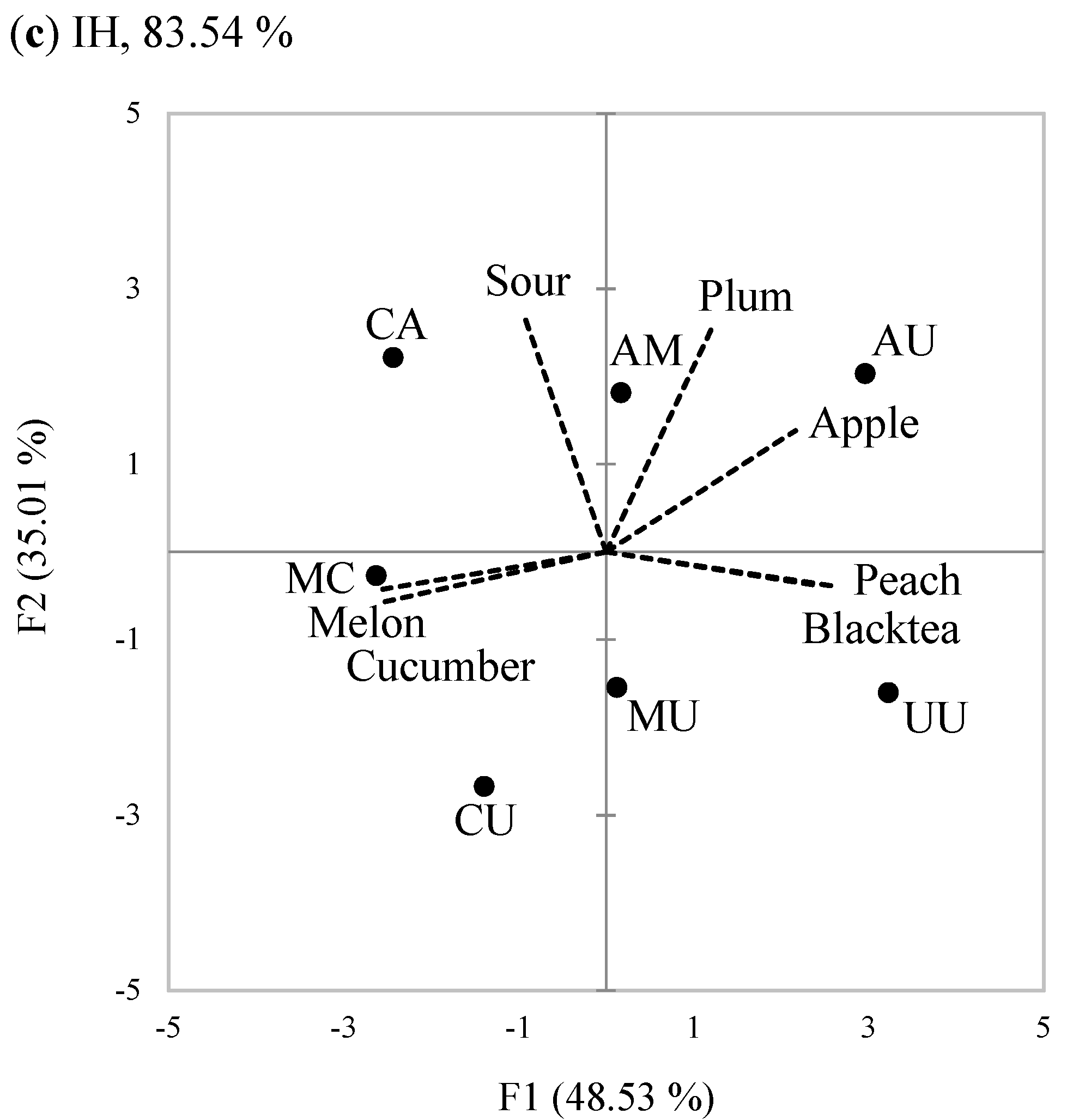
 ; IM,
; IM,  ; IH,
; IH,  , (b) NL,
, (b) NL,  ; NM,
; NM,  ; NH,
; NH,  . See Table 1 for sample codes.
. See Table 1 for sample codes.
 ; IM,
; IM,  ; IH,
; IH,  , (b) NL,
, (b) NL,  ; NM,
; NM,  ; NH,
; NH,  . See Table 1 for sample codes.
. See Table 1 for sample codes.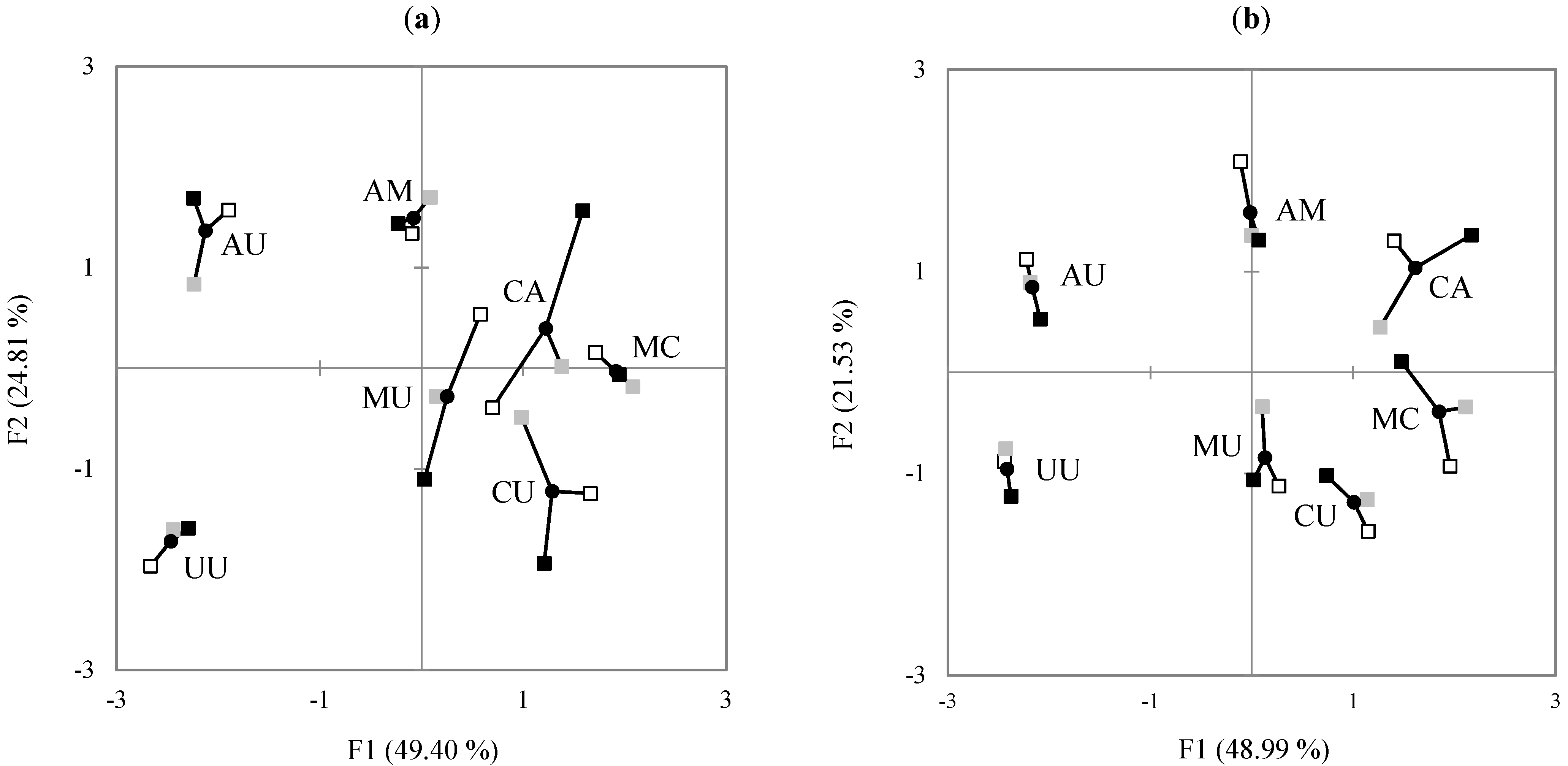
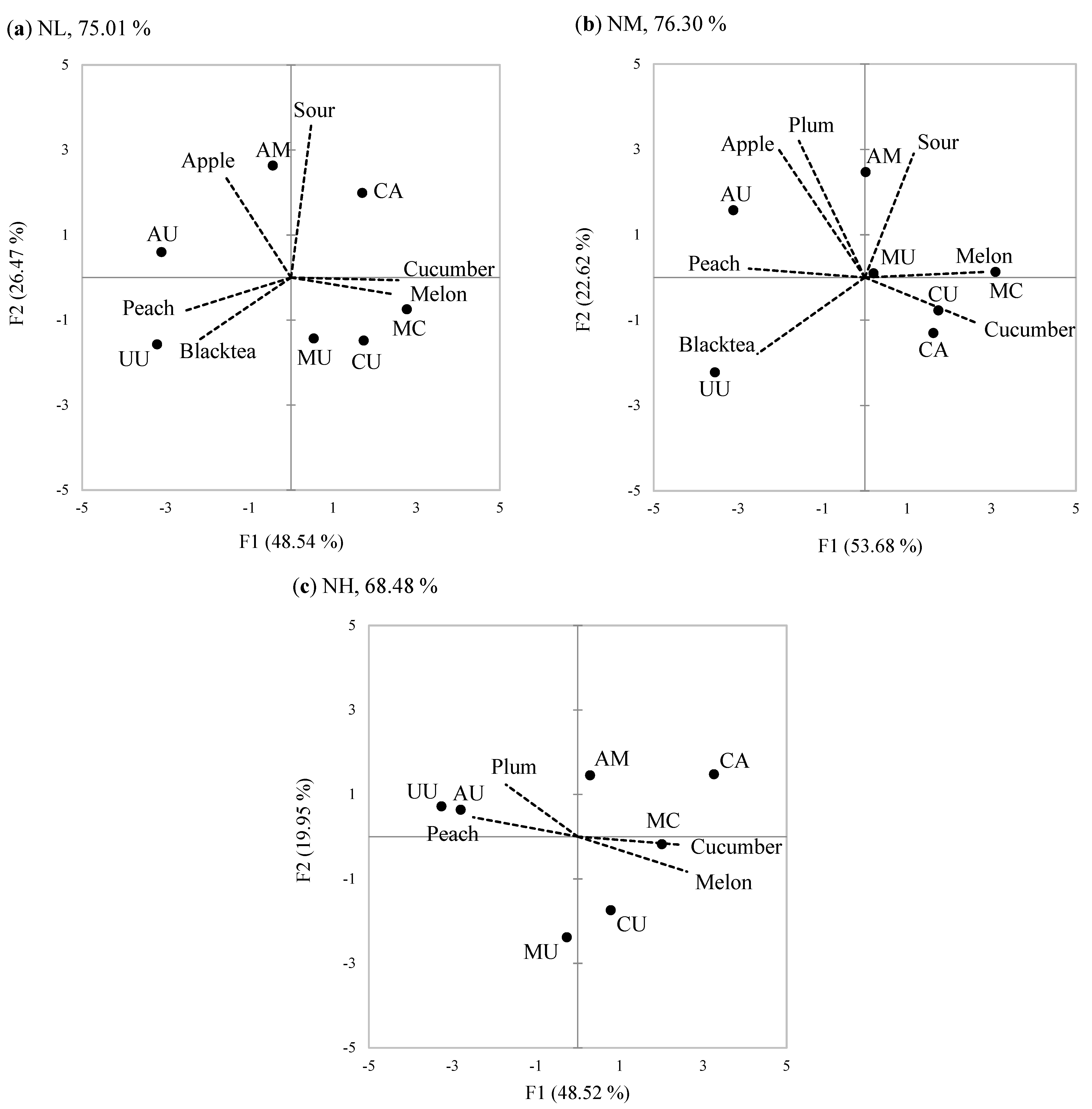
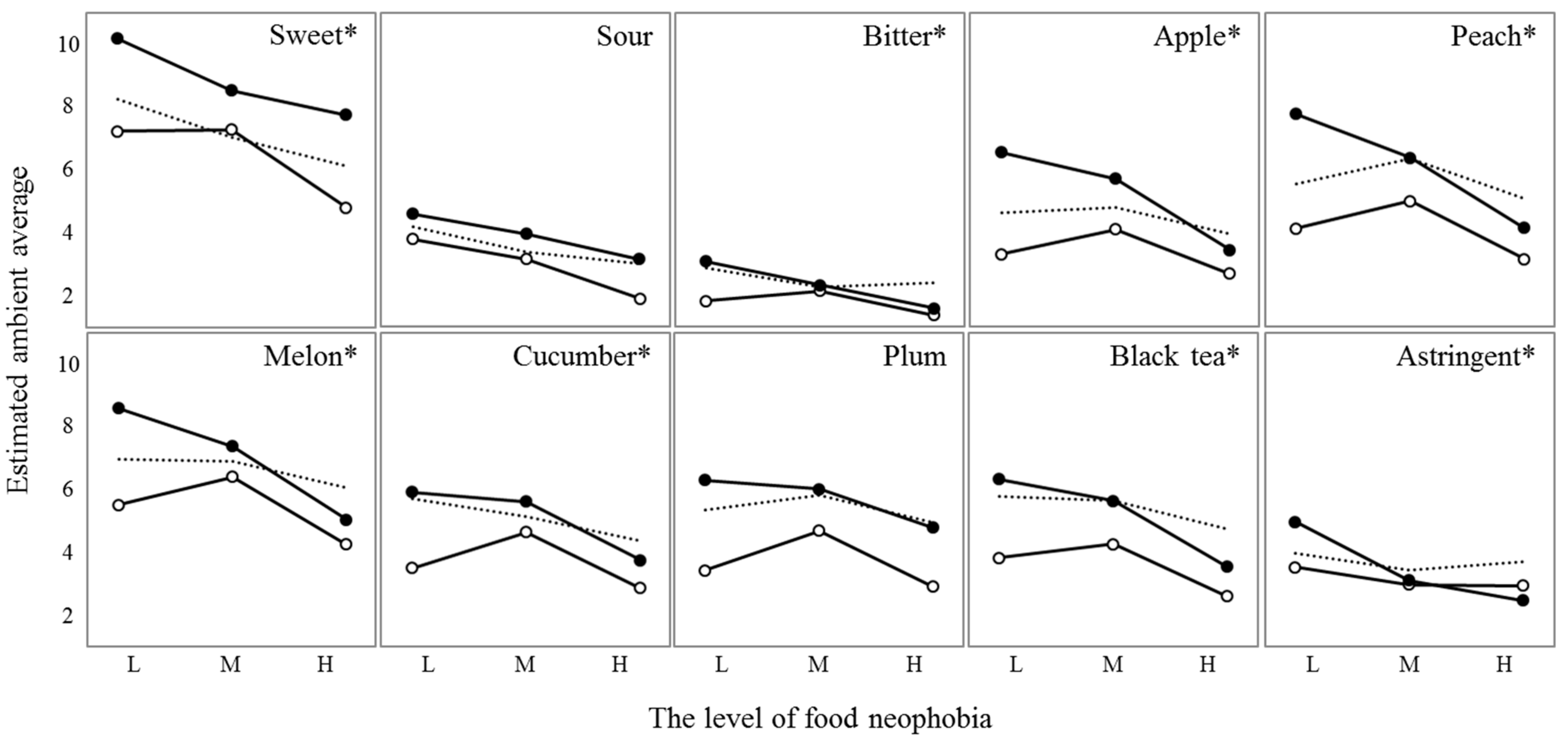
| Sample Code | Features | ||||
|---|---|---|---|---|---|
| Composition | °Brix (%) | ||||
| High | Low | Low | Mean | (±SD) | |
| UU | Peach | Unflavored | Unflavored | 7.27 | (0.12) |
| AU | Peach | Apple | Unflavored | 7.40 | (0.00) |
| MU | Peach | Melon | Unflavored | 7.40 | (0.00) |
| CU | Peach | Cucumber | Unflavored | 7.40 | (0.00) |
| AM | Peach | Apple | Melon | 7.40 | (0.00) |
| MC | Peach | Melon | Cucumber | 7.40 | (0.00) |
| CA | Peach | Cucumber | Apple | 7.33 | (0.12) |
| Variable | Categories | Involvement 1 | Neophobia 2 | N | ||
|---|---|---|---|---|---|---|
| Mean | Range | Mean | Range | |||
| Gender | Male | 52.00 | 15–88 | 29.12 | 11–61 | 99 |
| Female | 58.90 | 15–99 | 31.95 | 10–60 | 146 | |
| Age groups | 10–19 yrs | 51.41 | 15–99 | 34.25 | 15–60 | 32 |
| 20–29 yrs | 59.21 | 18–96 | 29.22 | 10–61 | 120 | |
| 30–39 yrs | 56.98 | 21–93 | 29.06 | 12–56 | 50 | |
| 40–49 yrs | 50.43 | 18–74 | 34.19 | 20–51 | 21 | |
| 50–59 yrs | 50.86 | 27–87 | 34.93 | 24–52 | 14 | |
| 60 yrs+ | 47.13 | 15–88 | 35.63 | 13–58 | 8 | |
| Education 3 | Low | 47.83 | 15–99 | 36.15 | 13–61 | 54 |
| Medium | 61.53 | 18–96 | 32.38 | 19–60 | 78 | |
| High | 56.33 | 21–90 | 27.17 | 10–56 | 113 | |
| Attributes | Group | Samples 2 | ||||||
|---|---|---|---|---|---|---|---|---|
| No Other Syrup (UU) | Apple (AU) | Melon (MU) | Cucumber (CU) | Apple and Melon (AM) | Melon and Cucumber (MC) | Cucumber and Apple (CA) | ||
| Sweet | IL | 7.48 | 6.92 | 6.66 | 6.62 | 6.72 | 6.8 | 6.95 |
| IM | 7.58 | 7.64 | 7.19 | 7.41 | 6.95 | 6.61 | 6.62 | |
| IH | 9.16 | 8.73 | 9.1 | 9.18 | 8.48 | 8.06 | 8.34 | |
| Sour | IL | 2.18 a | 3.20 ab | 2.83 ab | 2.26 a | 3.79 b | 3.25 ab | 3.43 ab |
| IM | 2.87 a | 3.30 ab | 3.23 ab | 3.19 ab | 4.04 b | 3.38 ab | 3.79 ab | |
| IH | 2.88 a | 3.98 ab | 3.63 ab | 3.15 a | 4.64 ab | 3.55 ab | 5.18 c | |
| Bitter | IL | 2.52 | 1.87 | 1.95 | 2.11 | 2 | 1.74 | 2.13 |
| IM | 2.76 | 2.62 | 2.41 | 2.39 | 2.3 | 2.15 | 2.72 | |
| IH | 2.25 | 2.7 | 2.19 | 2.25 | 2.46 | 2.39 | 2.7 | |
| Apple | IL | 3.67 a | 5.55 b | 3.87 a | 2.85 a | 4.08 ab | 3.13 a | 3.54 a |
| IM | 4.31 ab | 6.36 c | 4.34 ab | 4.39 ab | 5.61 bc | 4.03 a | 4.13 a | |
| IH | 5.67 ab | 7.42 b | 5.27 a | 4.70 a | 6.27 ab | 4.53 a | 4.55 a | |
| Peach | IL | 4.89 | 4.89 | 4.9 | 4.13 | 4.72 | 4.3 | 4 |
| IM | 7.06 b | 6.62 ab | 6.21 ab | 5.70 ab | 6.09 ab | 5.35 a | 5.29 a | |
| IH | 7.88 c | 7.09 bc | 6.58 abc | 5.58 ab | 6.03 abc | 4.90 a | 5.40 ab | |
| Melon | IL | 3.25 a | 3.52 a | 7.33 b | 7.08 b | 6.18 b | 7.47 b | 6.64 b |
| IM | 4.01 a | 4.16 a | 7.91 b | 7.85 b | 7.29 b | 8.48 b | 8.13 b | |
| IH | 3.49 a | 3.54 a | 8.76 b | 8.72 b | 7.01 b | 9.40 b | 9.28 b | |
| Cucumber | IL | 2.82 ab | 2.67 a | 3.79 abc | 6.15 d | 3.72 abc | 5.49 cd | 4.77 bcd |
| IM | 3.03 a | 3.16 a | 4.68 b | 7.32 c | 4.52 ab | 6.59 c | 6.92 c | |
| IH | 3.19 a | 3.00 a | 4.52 a | 7.70 d | 4.90 c | 7.19 ab | 6.90 c | |
| Plum | IL | 4.69 ab | 5.30 b | 3.59 ab | 3.46 a | 4.75 ab | 3.75 ab | 3.88 ab |
| IM | 5.44 ab | 6.54 b | 5.50 ab | 5.04 a | 6.72 b | 4.89 a | 5.62 ab | |
| IH | 5.45 ab | 7.07 b | 5.57 ab | 5.03 a | 6.45 ab | 5.58 ab | 5.77 ab | |
| Black tea | IL | 4.97 | 4.1 | 3.62 | 3.8 | 3.77 | 3.39 | 4.12 |
| IM | 7.14 b | 5.91 ab | 5.46 a | 5.03 a | 5.32 a | 4.89 a | 5.36 a | |
| IH | 6.94 b | 5.85 ab | 5.18 ab | 4.97 a | 5.39 ab | 4.61 a | 4.81 a | |
| Astringent | IL | 3.46 | 2.93 | 2.61 | 3.07 | 2.85 | 3.21 | 3.28 |
| IM | 3.85 | 3.21 | 3.44 | 3.34 | 3.48 | 3.56 | 3.96 | |
| IH | 3.42 | 3.25 | 3.18 | 2.91 | 3.69 | 3.25 | 3.93 | |
| Attributes | Group | Samples 2 | ||||||
|---|---|---|---|---|---|---|---|---|
| UU | AU | MU | CU | AM | MC | CA | ||
| Sweet | NL | 9.09 | 8.96 | 8.64 | 8.36 | 8.6 | 8.53 | 8.2 |
| NM | 7.91 | 7.72 | 7.55 | 7.71 | 7.33 | 6.86 | 7.11 | |
| NH | 7 | 6.5 | 6.45 | 6.84 | 5.68 | 6.13 | 6.21 | |
| Sour | NL | 3.2 | 4.22 | 3.48 | 3.16 | 5.3 | 4.02 | 5.69 |
| NM | 2.65 a | 3.37 abc | 3.41 abc | 2.97 ab | 4.05 c | 3.44 abc | 3.83 bc | |
| NH | 2.32 | 2.92 | 2.24 | 2.61 | 3.21 | 2.45 | 3.24 | |
| Bitter | NL | 2.93 | 2.71 | 2.64 | 2.93 | 2.96 | 2.47 | 2.71 |
| NM | 2.58 | 2.51 | 2.24 | 2.25 | 2.15 | 2.05 | 2.62 | |
| NH | 2.05 | 1.92 | 1.74 | 1.68 | 1.95 | 1.95 | 2.18 | |
| Apple | NL | 4.27 a | 7.49 c | 4.20 a | 4.07 a | 6.49 bc | 3.78 a | 4.84 ab |
| NM | 4.81 ab | 6.56 c | 4.83 ab | 4.20 a | 5.50 bc | 4.27 a | 4.20 a | |
| NH | 3.63 | 4.79 | 3.3 | 3.66 | 3.74 | 2.74 | 2.76 | |
| Peach | NL | 7.20 b | 6.80 ab | 6.42 ab | 5.42 ab | 5.76 ab | 4.53 a | 5.31 ab |
| NM | 6.81 b | 6.59 ab | 6.25 ab | 5.58 ab | 6.00 ab | 5.48 a | 5.34 a | |
| NH | 5.87 b | 4.58 ab | 4.34 ab | 3.82 ab | 4.57 ab | 3.29 a | 3.14 a | |
| Melon | NL | 3.51 a | 3.07 a | 10.44 b | 8.47 b | 7.16 b | 9.38 b | 8.09 b |
| NM | 3.97 a | 4.19 a | 7.72 bc | 8.33 bc | 7.27 b | 8.67 c | 8.27 bc | |
| NH | 2.59 a | 3.24 a | 6.26 b | 5.37 ab | 5.29 ab | 6.66 b | 7.24 b | |
| Cucumber | NL | 2.67 a | 2.78 a | 4.22 a | 8.00 c | 4.53 ab | 7.84 c | 6.98 bc |
| NM | 3.35 ab | 3.15 a | 4.83 c | 7.33 d | 4.57 bc | 6.47 d | 6.48 d | |
| NH | 2.05 a | 2.58 ab | 2.87 abc | 5.26 c | 3.68 abc | 4.92 bc | 5.27 c | |
| Plum | NL | 5.11 | 6.33 | 4.98 | 4.11 | 6.04 | 4.4 | 5.62 |
| NM | 5.52 abc | 6.35 bc | 5.28 ab | 5.08 a | 6.59 c | 5.04 a | 5.48 abc | |
| NH | 4.32 ab | 6.51 b | 4.13 ab | 3.42 a | 4.42 ab | 4.29 ab | 3.68 a | |
| Black tea | NL | 7.18 | 5.96 | 5.07 | 5.34 | 5 | 5.04 | 5.09 |
| NM | 6.68 b | 5.58 ab | 5.22 a | 4.85 a | 5.19 a | 4.51 a | 5.31 a | |
| NH | 5.16 | 4.22 | 3.53 | 3.39 | 3.87 | 3.42 | 2.89 | |
| Astringent | NL | 4.29 | 4.29 | 4.29 | 4.29 | 4.29 | 4.29 | 4.29 |
| NM | 3.52 | 3.04 | 3.12 | 2.94 | 3.1 | 3.21 | 3.72 | |
| NH | 3.32 | 2.76 | 2.53 | 3.05 | 3.11 | 3.21 | 3.27 | |
Publisher’s Note: MDPI stays neutral with regard to jurisdictional claims in published maps and institutional affiliations. |
© 2021 by the authors. Licensee MDPI, Basel, Switzerland. This article is an open access article distributed under the terms and conditions of the Creative Commons Attribution (CC BY) license (http://creativecommons.org/licenses/by/4.0/).
Share and Cite
Lee, Y.-M.; Chung, S.-J.; Prescott, J.; Kim, K.-O. Flavor Profiling by Consumers Segmented According to Product Involvement and Food Neophobia. Foods 2021, 10, 598. https://doi.org/10.3390/foods10030598
Lee Y-M, Chung S-J, Prescott J, Kim K-O. Flavor Profiling by Consumers Segmented According to Product Involvement and Food Neophobia. Foods. 2021; 10(3):598. https://doi.org/10.3390/foods10030598
Chicago/Turabian StyleLee, Yun-Mi, Seo-Jin Chung, John Prescott, and Kwang-Ok Kim. 2021. "Flavor Profiling by Consumers Segmented According to Product Involvement and Food Neophobia" Foods 10, no. 3: 598. https://doi.org/10.3390/foods10030598
APA StyleLee, Y. -M., Chung, S. -J., Prescott, J., & Kim, K. -O. (2021). Flavor Profiling by Consumers Segmented According to Product Involvement and Food Neophobia. Foods, 10(3), 598. https://doi.org/10.3390/foods10030598






